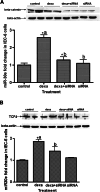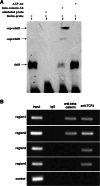Beta-catenin/TCF4 transactivates miR-30e during intestinal cell differentiation
- PMID: 20372961
- PMCID: PMC2921486
- DOI: 10.1007/s00018-010-0366-y
Beta-catenin/TCF4 transactivates miR-30e during intestinal cell differentiation
Abstract
The Wnt/beta-catenin/TCF4 pathway plays critical roles in the maintenance of small intestinal epithelium; however, downstream targets of the beta-catenin/TCF4 complex are not extensively characterized. We identified miR-30e as an immediate target activated by the beta-catenin/TCF4 complex. miR-30e was detected in the peri-nuclear region of the intestinal crypt IEC-6 cells. Bioinformatics analysis revealed clustered beta-catenin/TCF4 binding sites within the miR-30e promoter region. This promoter region was cloned into pGL3-control luciferase reporter vector, with the enhancer region removed. Transfection of pCMV-SPORT6-beta-catenin expression vector dose-dependently increased luciferase activity, and co-transfection of pCMV-SPORT6-TCF4 expression vector further enhanced the promoter activity. Dexamethasone-induced IEC-6 cells differentiation caused a 2.5-fold increase in miR-30e expression, and upon beta-catenin siRNA transfection, miR-30e increased 1.3-fold. Electrophoretic mobility shift assay and chromatin immunoprecipitation assay confirmed the binding between beta-catenin/TCF4 complexes from IEC-6 nuclear extracts and the putative sequences in the miR-30e promoter. These results demonstrate that beta-catenin/TCF4 transactivates miR-30e during intestinal cell differentiation.
Figures





Similar articles
-
Multi-level interactions between the nuclear receptor TRα1 and the WNT effectors β-catenin/Tcf4 in the intestinal epithelium.PLoS One. 2012;7(4):e34162. doi: 10.1371/journal.pone.0034162. Epub 2012 Apr 3. PLoS One. 2012. Retraction in: PLoS One. 2020 Feb 5;15(2):e0228994. doi: 10.1371/journal.pone.0228994. PMID: 22509275 Free PMC article. Retracted.
-
The leukemia-associated Mllt10/Af10-Dot1l are Tcf4/β-catenin coactivators essential for intestinal homeostasis.PLoS Biol. 2010 Nov 16;8(11):e1000539. doi: 10.1371/journal.pbio.1000539. PLoS Biol. 2010. PMID: 21103407 Free PMC article.
-
β-catenin/TCF4 complex induces the epithelial-to-mesenchymal transition (EMT)-activator ZEB1 to regulate tumor invasiveness.Proc Natl Acad Sci U S A. 2011 Nov 29;108(48):19204-9. doi: 10.1073/pnas.1108977108. Epub 2011 Nov 11. Proc Natl Acad Sci U S A. 2011. PMID: 22080605 Free PMC article.
-
MAD2B, a novel TCF4-binding protein, modulates TCF4-mediated epithelial-mesenchymal transdifferentiation.J Biol Chem. 2009 Jul 17;284(29):19613-22. doi: 10.1074/jbc.M109.005017. Epub 2009 May 14. J Biol Chem. 2009. PMID: 19443654 Free PMC article.
-
Attenuation of the beta-catenin/TCF4 complex in colorectal cancer cells induces several growth-suppressive microRNAs that target cancer promoting genes.Oncogene. 2012 May 31;31(22):2750-60. doi: 10.1038/onc.2011.453. Epub 2011 Oct 3. Oncogene. 2012. PMID: 21963845
Cited by
-
Global microRNA characterization reveals that miR-103 is involved in IGF-1 stimulated mouse intestinal cell proliferation.PLoS One. 2010 Sep 23;5(9):e12976. doi: 10.1371/journal.pone.0012976. PLoS One. 2010. PMID: 20886090 Free PMC article.
-
Tissue-specific differences in the regulation of KIBRA gene expression involve transcription factor TCF7L2 and a complex alternative promoter system.J Mol Med (Berl). 2014 Feb;92(2):185-96. doi: 10.1007/s00109-013-1089-y. Epub 2013 Sep 27. J Mol Med (Berl). 2014. PMID: 24072042
-
Wnt-signalling pathways and microRNAs network in carcinogenesis: experimental and bioinformatics approaches.Mol Cancer. 2016 Sep 2;15(1):56. doi: 10.1186/s12943-016-0541-3. Mol Cancer. 2016. PMID: 27590724 Free PMC article. Review.
-
Growth factor TGF-β induces intestinal epithelial cell (IEC-6) differentiation: miR-146b as a regulatory component in the negative feedback loop.Genes Nutr. 2013 Jan;8(1):69-78. doi: 10.1007/s12263-012-0297-3. Epub 2012 May 9. Genes Nutr. 2013. PMID: 22570175 Free PMC article.
-
Wnt-Signaling Regulated by Glucocorticoid-Induced miRNAs.Int J Mol Sci. 2021 Oct 29;22(21):11778. doi: 10.3390/ijms222111778. Int J Mol Sci. 2021. PMID: 34769207 Free PMC article.

